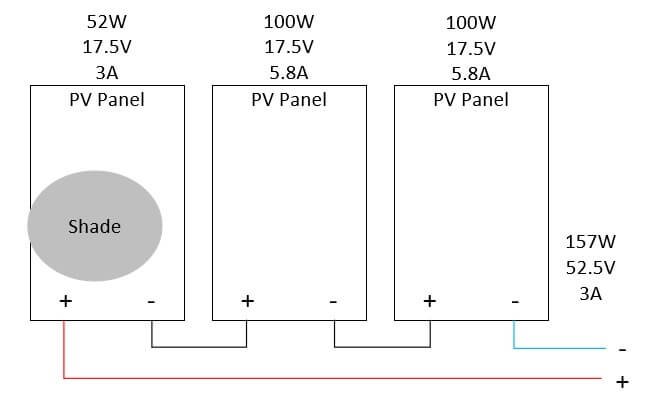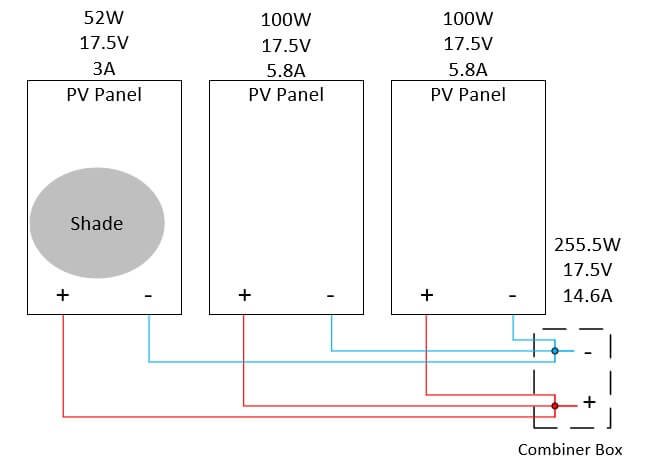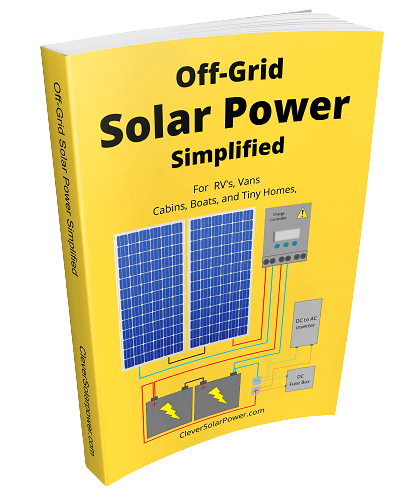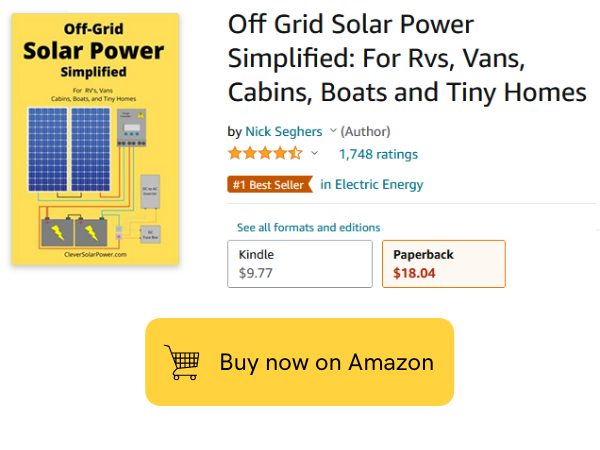Like it or not,
Shade is the enemy of solar panels.
If you have an off-grid homestead, RV, van, or even a sailboat you could significantly reduce the power output of your panels.
In this article, I’m going to explain how you can remedy shading on your solar panels.
What’s so bad about shade on solar panels?
When there is shade on solar panels it will reduce the current of that panel.
Let’s say you have a panel that has a rating of 17.5 Volts and 5.8 Amps, it will produce 100Watts.
Now if shade comes over the panel, the current could drop to 3 Amps, but the voltage stays the same, resulting in 52.5 Watts (3 Amps x 17.5 Volts).
There is really nothing you can do about this if you have a single solar panel.
What is the effect of shaded PV cells in series and parallel?
The problem arises if you have multiple solar panels.
Multiple solar panels can be connected in series or parallel.
Most of the time, your panels will be connected in series. Want to know why? Check out my article on series and parallel wiring of solar panels.
Effect of shading in series connections
If you expect to have shade on your panels, adding panels in series is not the best configuration.
Remember that in series the voltage is added up and the current stays the same?
If there is shade on one panel, the current will drop. In a series connection, the current will take the lowest value in the string which is 3 amps in the following example:

The shaded spot on one panel will decrease the string of panels to 3 amps at 52.5 volts. This means that the total power will be reduced from 300 Watts (52.5 Volts x 5.8 Amps) to 157 Watts (52.5 Volts x 3 Amps).
Are you keeping up?
Let’s look at what parallel does.
Effect of shading in parallel connections
If we do the same experiment with parallel connections, we see that we have a higher power output.
This is because in parallel connections voltage stays the same but current is added together.
Remember that solar irradiance (sunshine) only has an impact on the current and not on voltage?
Therefore we add 3 amps + 5.8 amps + 5.8 amps to become 14.6 amps total. If we multiply this by the voltage of 17.5 we become 255 Watts which is higher than the 157 Watts in a series connection.

If you expect shading on your solar panels, I recommend putting them in a parallel configuration.
If you wire your panels in parallel, the current is higher which means you need to increase the wire diameter. This will increase the cost of your solar system. Therefore, you need to include a combiner box and make the distance between the combiner box and the charge controller as short as possible.
Conclusion
If you have no problems with shade, you can wire your panels in series. Wiring panels in series in cheaper and is better for your MPPT charge controller. Most MPPT charge controllers can take a maximum of 100 Volts. If you exceed this, you need a hybrid solar panel setup (series and parallel combination).
If you have an RV or a van and plan to move a lot, you are better off with a parallel connection. This is because you are not always certain if there is going to be sunshine all the time on all your panels. Yes, it will cost you more in wiring but it will pay off in the long term. Especially if your battery bank is running low.
FAQ
Series or parallel solar panels for RV?
In an RV, you will expect shading to happen. It can be a branch or a fallen leaf on the panels. In an RV you want to harvest every watt you can. That’s why you should wire the panels of your RV in parallel. It will cost you more in wiring, but it is worth it.
Is it better to series or parallel solar panels?
You should wire your panels in series if there is no shade. If there is shade, the best way to wire your panels is in parallel. Don’t forget that the wires need to be bigger when wiring in parallel. This will increase the cost. Keep in mind that you can only add so many in panels in series up until the charge controller allows it.
How does shading affect solar panels in parallel?
Shading affects the current (A) of the solar panel. The voltage (V) is affected by temperature.
Do solar panels charge faster in series or parallel?
This is a tricky question. Generally, batteries get charged quicker in series because of low light in the early morning and late evening. Because voltage is added up in a series connection, the minimum required voltage to start charging the battery is reached faster.
What type of solar panel works best in shade?
Improvements in solar panel technology make polycrystalline and monocrystalline practically the same. There is no significant difference in how both technologies handle shaded conditions. However, polycrystalline technology has a bigger surface area than monocrystalline for the same amount of power generation.
What happens if a solar panel is partially shaded?
The current of the solar panel that is shaded will drop significantly, reducing the total current output of the whole series string.
Do solar panels work in the shade?
You will get a tiny amount of power from shaded solar panels compared to the full sun. Let’s say it’s about 10-20% of the rated power.
[custom-related-posts title=”Related Posts” none_text=”” order_by=”title” order=”ASC”]
I’m an off-grid enthusiast. I created this website to give clear and straight-to-the-point advice about solar power. I’m also the author of the book ‘Off-grid solar power simplified‘. Read more about me on my about page, check out my Youtube channel, or send me a message.


Can you add what happens if the shading of a cell of one panel is so severe that a bypass diode “kicks in” causing the loss of say 1/3 of the panel.
Once the resistance of the cells is high enough, and it’s more than the resistance of the diode, the current will go through the diode. Preventing hotspots for forming on the panel. I don’t know the actual value or time when the diode takes over.
The diagrams above “Effects of shading on a solar system in parallel. The image is taken from my book.” do not initially make sense because the “100W” panels are actually making a little more than 100W.
eg the paralleled panels
52W+100W+100W = 252W
while it is shown as 255.5W
I rounded up the power of each panel to make it look simpler. So each 100W panel is ‘missing’ 1,5 Watts. I’m sure you understand.
AE Solar makes a panel with a diode on each cell so that shaded cells are bypassed. Shouldn’t that make the loss from shade the same for series as it is for parallel connections of two panels?
From my understanding, that would solve the problem we face with series connections partially. But that will come at a price. It’s certainly promising, but most people always put their panels in the sun. I can see it being useful for RV’s or boats.
The reason I say partially is that the current would still be reduced but in a smaller amount. If you then connect them in series, the panels will drop down to the current of the lowest value panel like shown in the series example. If you expect shade I still recommend using parallel wiring.
My understanding is that when cells are bypassed, it is only volts that are lost. If all the other cells are unimpaired then you wouldn’t lose any current. So, in my example you could lose 1/3 of the voltage of one panel and then you would be better off with the two panels being connected in series. The application I’m interested in is a narrowboat where the panels regularly experience unequal light levels. I’ve heard of people wiring their two panels both ways with a switch so that they can select whichever scheme (serial or parallel) gives the greater output in the prevailing conditions.
if i have 4 panels @ 270w and only 1 gets shading, should i have 3 in series and parallel up the on that gets shaded
The first option is to wire them all in parallel. The second option is to wire the three sunny panels in series to one charge controller and the shaded panel to another charge controller.
Hi
On this situation don’t need to wire them in parallel and series but only in series. What you need to introduce is a bypass diodes on each panel so that if 1 panel is shaded the bypass will take over and current on whole string in series will not be affected with shaded panel.
In my opinion, that’s not the ideal solution.
Thank you
Somehow in my mind I had applied the serial panel case to single panels, thinking that even partial shade would severely impact output. Today I was working on a simple gate opening system and noted the shaded panel still provided 20V but only 500mA (reduced but not useless), which surprised me and lead to further education 🙂
Depending on how the shade casts on the panel, the output will be severely reduced. If it’s a tree trunk over the width of the panel, then the output would be reduced a lot. If it’s a small leaf, the bypass diodes will work and the panel would still give 2/3 of its rated output. Indeed, the solar radiation will have an effect on the current while the temperature has an effect on the voltage. So what you saw there is perfectly normal.
I would be interested in understanding what happens if a solar panel is (partially) broken due to several reasons, e.g. aging or a manufacturing problem.
My understanding is that this would also have an effect if connected in series, right!?
Following this thought isn‘t it not worth spending a little bit more on wiring and to always consider a parallel configuration?
What are the real technical disadvantages of a parallel configuration besides the financial?
Thank you!
Good question. The thing is that no panel breaks if it’s well taken care of. If the panel is broken, then it needs to get replaced, period. Series is always preferred because to save on wiring cost like you said, but also on voltage drop (system’s efficiency) this also ties in with wiring cost. If you have an application where reliability is a must, then wiring in parallel is okay if you want to spend extra money on wires. Just do the calculation yourself for a house system, you will spend $100’s more on wires.
“solar irradiance (sunshine) only has an impact on the current and not on voltage” is obviously not true, the open circuit voltage depends continuously on the amount of light; what voltage do you think is generated in the dark ?
Look at the I-V curve of a solar panel. Irradiance (sunshine) has a lot of effect on the Current, not voltage. Panels in the shade generate the same voltages (very close) as panels in the sun. Irradiance influences current, not voltage. Temperature influences voltage, not current.
I’m assuming your examples are based on using an mppt controller vs a pwm controller. It seems that if you were using a pwm controller, your volts would be cut down and you’d end up with something around 178 watts. Is this correct? My RV has three 170 watt panels in parallel, which at 9.4 amps per panel should give me over 27 amps, however with my pwm controller, that max I seems to get is about 18.6 amps. That seems to correspond with the 30% lost that I hear about between an mppt vs a pwm controller.
I did an article about the efficiency of PWM and MPPT here: https://cleversolarpower.com/pwm-vs-mppt-solar-charge-controller/
Hi Great site. Thanks for the info. Are you familiar with Peter Lindemann and this book of his?
He believes that amorphous panels are the way to go: “Year-on-year, in real world conditions, the Amorphous Silicon panels will
provide 30% to 60% more electricity than a similarly rated Crystalline
Silicon panel will. If they rated the panels based on how many kilo-watthours they produce in a year, the Amorphous Silicon panel would be rated #1!”
He also promotes the John Bedini battery chargers. Here is an excerpt of a presentation he did: https://emediapress.com/shop/advanced-solar-methods/
Any thoughts? Thanks
I have not read or watched his material before. I will take a look at it. Thank you for pointing it out. As of now Amorphous Silicon panels have a low efficiency. About 10% for amorphous (15% theoretical limit) and 20% for mono.
I have 2 solar strings in series. The VOC is within 2V, however in operation I can get some large output swings. Is it feasible to install blocking diodes to prevent back feed from the high panels to the low panels?
Voltage depends on temperature. Current on sunshine. If you have large voltage swings, it means that there is a temperature difference. Why is that a problem for your system?
Most excellent article. On my RV, when I added two panels (470w total) to my PWM 30a controller, I was at best 10a coming off the panels. Looking at it real hard, I found the 200w panel was being shadowed and only getting 100w total.
.
Now, I’ve already gone down this path redoing the entire system, but I’d love to read your opinion. I’m very space limited, and the max I can “reasonably” put on the roof is six 200w panels. I put one string on drivers side, one string on pass side, each side wired in parallel and going to it’s own SCC. Biggest thing I did that has gotten some people worked up, went with 24v panels on a 12v system. Yes, I completely understand how that effects wire size, but the idea was to drive up panel voltage without going into series and let SCC straighten it out. I still have a lot of work to do to complete the installation, but the panels are up and getting ready to run wires. Still struggling to find a home for all the electronics and 4 group 27 LiFeO4 batteries. I don’t want the most logical location, but no matter how long I look at it, it’s still the most logical location.
Hello Phil,
I recommend having a voltage as high as your max allowable input of the charge controller (Voc*1.25= max input voltage). This will limit voltage drop. So using 24V panels on a 12V system is ok. I would even go with 40V, 10A panels if they fit. In order to minimize the shade you indeed need to put them in parallel. You can also use optimizers if they are in series, but that has an additional cost.
If I understand correctly, you are using a 2x 3P system with two charge controllers in total. Looks good to me to minimize shading and voltage drop.
hi nice articles
I have asked amazon for your books(paid )
but still nor received
can you help
regards
scooby
Hello Scooby, thanks for getting the book. Have you tried contacting amazon customer service? They should be pretty responsive.
I have 12 panels in 6S-2P with 6 facing south and 6 facing west. Obviously they are not getting sun at the same time. I was expecting the 6 facing south would produce in the morning to noon-ish and the west panels to take over in the afternoon. I wasn’t getting the numbers I expected so called tech support. First thing I learned is if they were both getting sun I probably would have fried my charge controller since the amps would have doubled, I misinterpreted the amps my AIO Growatt 5K would handle. So he recommended wiring all in series, which I originally was planning to do but was talked into the 6S-2P by a different technician. But installing optimizers on each panel so the shade or lack of sun would not reduce all panels to the lowest number. What is your opinion on optimizers and how to use them?
I don’t recommend wiring in series on different orientations.
Seems like you have a hybrid inverter. Does it have two mppt inputs or only one?
If it has two, you can wire the other to the other input and it’s solved.
If it’s not then i recommend getting another charge controller for the second string. Ensure the input voltage is high enough , or you have to rewire it in 3S2P (on string 2).